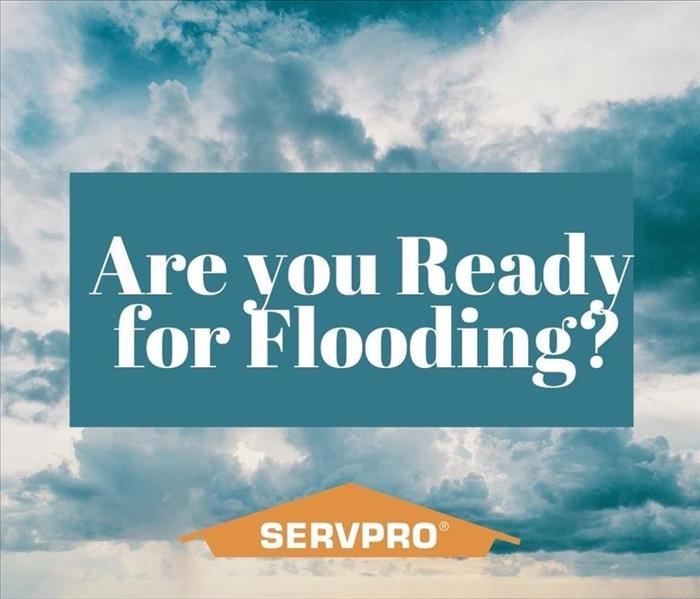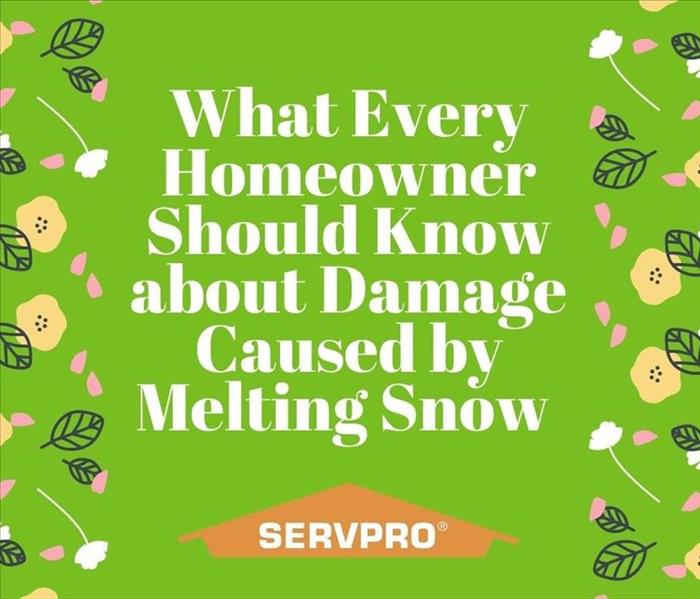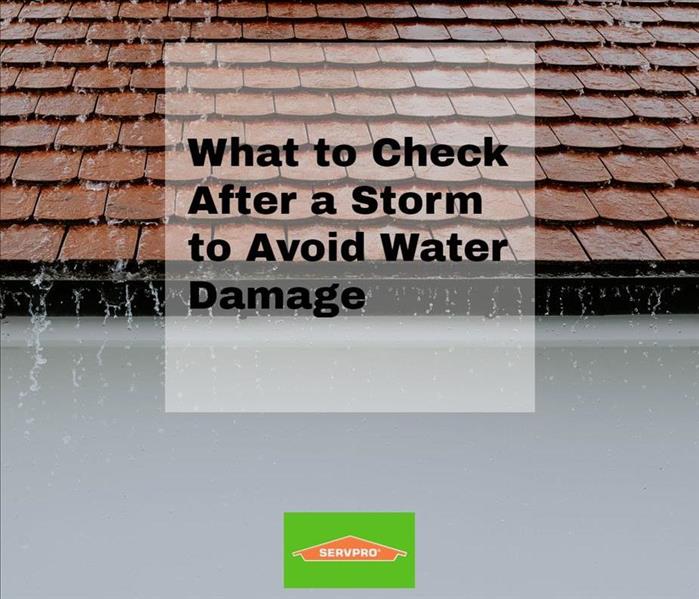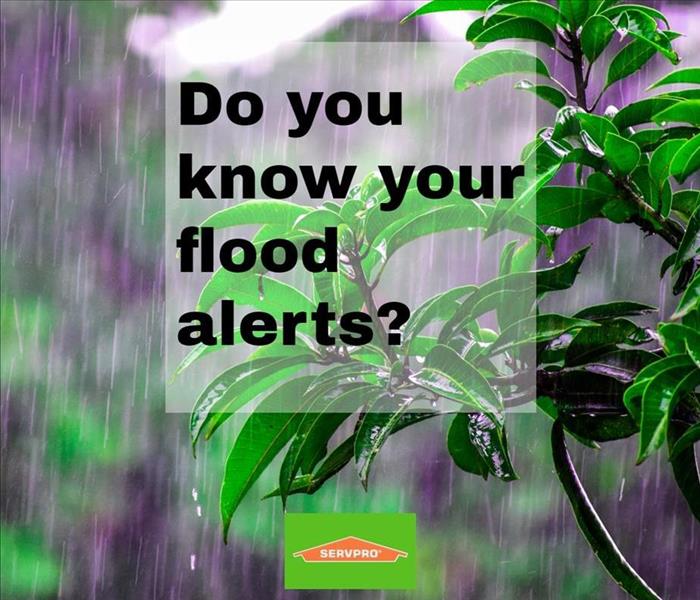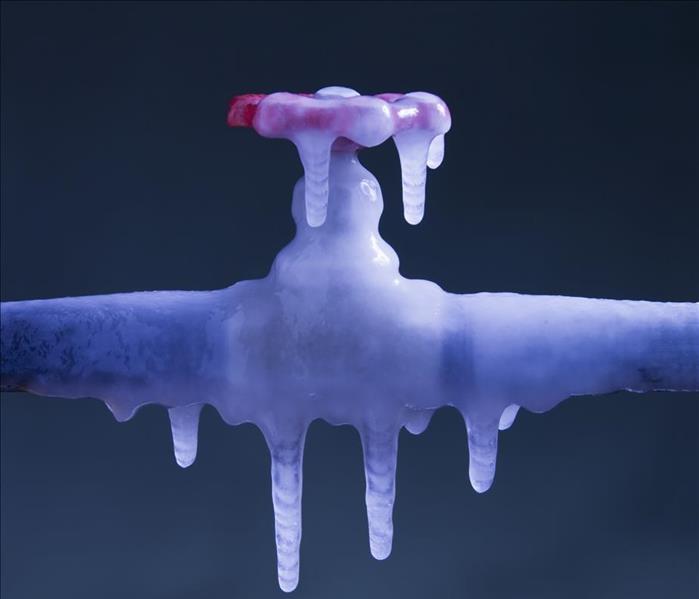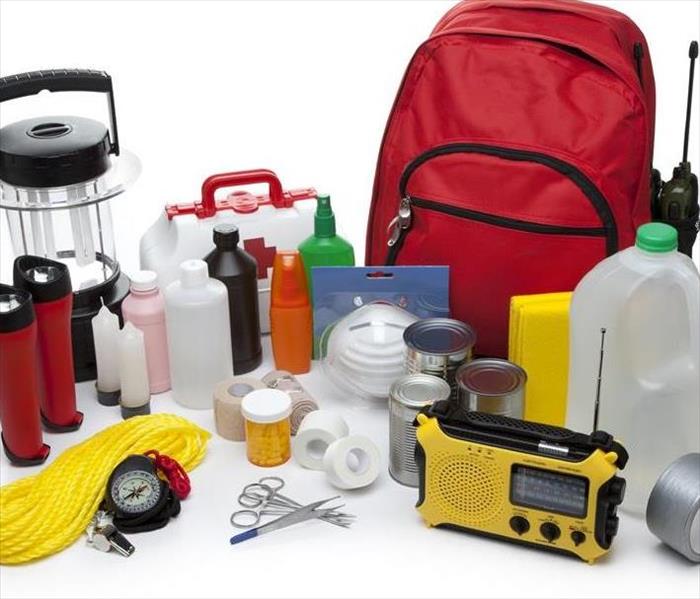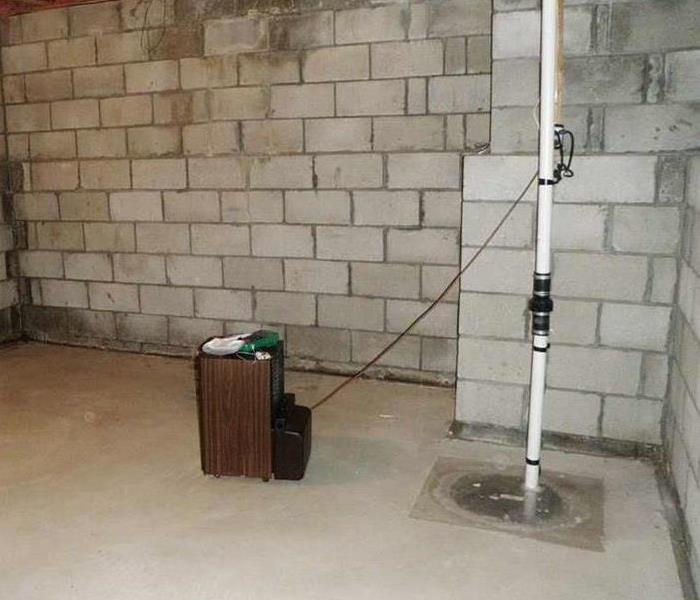Archived Storm Damage Blog Posts
Are you Ready for Flooding?
4/9/2021 (Permalink)
It’s almost mid-April, and April showers bring May flowers, but they could also bring dangerous floods. Flooding occurs when water temporary overflows onto land that is normally dry. There are different types of floods that can occur, like a river flood, which occurs when a river rises above the river banks, or a flash flood, which is a flood that begins within 6 hours of heavy rainfall.
Floods are the most common natural disaster in the United States and can be very dangerous: just six inches of moving water can knock a person down and a foot of water can sweep away a vehicle. Never try to swim or drive through flood waters.
If you are in a flood, find shelter immediately. Depending on the type of flood:
- Evacuate if told to do so
- Move to a higher floor or higher ground
- Stay where you are
Do you know the difference between flood warnings?
FLASH FLOOD WATCH or FLOOD WATCH
Flash flooding or flooding is possible within the designated watch area — be alert.
FLASH FLOOD WARNING or FLOOD WARNING
Flash flooding or flooding has been reported or is imminent — take necessary precautions at once! Get to higher ground!
How to Prepare for a Flood-
- Make a flood emergency plan.
- Prepare an emergency preparedness kit with a flashlight, batteries, etc.
- Raise furnaces, water heaters and electrical components above the base flood elevation level. Install a sump pump system to drain water away from your home.
- Seal basement walls to prevent water seepage
For more information on floods, check out ready.gov/floods.
What Every Homeowner Should Know About Damage Caused by Melting Snow
3/3/2021 (Permalink)
The snow is melting! While we’re all enjoying the warmer weather, especially after the terrible cold we’ve had the last few weeks, the melting snow is leaving a mushy mess. While we’re all imagining flowers blooming and sunshine, we have to be vigilant to make sure this melting snow doesn’t end up in our homes.
The water can easily seep into cracks in your foundation that have grown throughout the winter and cause major damage in your home. To avoid this, make sure any cracks are sealed as soon as you discover them. Also, set up a good drainage system for any melting snow. Your gutters should be angled and clear to make sure any water drains away from your home into the street drains.
Also, checking your sump pump and water tanks is important. The excess water created by melting snow can put strain on your sump pump, so it's vital to make sure that it's functioning properly. Inspect your hot water tank as well, because the water can freeze, which can cause it to expand. This can cause cracks, leaks, or tank bursts.
If you have experienced water damage in your home, please call SERVPRO of Norridge/Harwood Heights at 1-708-453-3655.
Things to Check after a Storm
8/1/2020 (Permalink)
Storms bring heavy winds and rain, and can cause thousands in damage. After a big storm, it is advisable that you check around your property to see what has been damaged. Some things, if left unattended, can cause further damage. These are the locations we recommend checking:
- Roof-Check for broken or missing shingles. The shingles are overlapped to help waterproof your roof. Without these shingles, your roof is vulnerable to water damage and if the water does get into your roof, it can cause mold.
- Gutters- Are your gutters draining properly? If they are clogged, water can seep into your roof or walls, which can be a costly fix.
- Basement- If the rains were heavy, it could overwhelm your sump pump and cause a flood in your basement.
Storms can be scary, but the aftermath can be even scarier and costly. Be proactive after a storm to help avoid any water damage.
Know Your Flood Alerts
7/24/2020 (Permalink)
Throughout the summer, we expect storms that form fast and cause damage in their path. These storms can bring heavy rainfall and with that rainfall, we experience floods.
We're lucky to have different technologies that can warn us of any flooding activity, like our TVs or our phones. But what exactly are the differences between the flood alerts?
Flood Watch
- Authorities think there is a chance that the rivers will overflow from heavy rain.
Flood Warning
- Authorities can indicate timing and locations of flooding. Flooding typically lasts longer than flash floods.
Flash Flood Watch
- Anticipate that heavy rains might occur or are expected; be ready to take action if the flood does occur. A flash flood is a flood that occurs from heavy rainfall in less than 6 hours.
Flash Flood Warning
- Sudden flash flooding is now occurring. Move to safety.
Do you know what to do in a flood? Check out Ready.gov to prepare.
SERVPRO Tips-Let's Get The House Ready for Winter
12/2/2019 (Permalink)
On this blog in the past weeks, we’ve been focused on winter tips, as winter is swiftly approaching. We talked about how to avoid frozen pipes and winter fire safety tips, but we’ll end our winter tips with getting the rest of the house ready for winter, while touching upon some of our past tips. Winter weather causes $1 billion in insured losses every year. With these tips, SERVPRO of Norridge/Harwood Heights hopes to help you avoid these losses.
- Protect indoor pipes- There is an entire blog post about this, but I wanted to touch upon it again, because it’s very important. A burst pipe can cause $5,000 or more in damage. Protect your pipes by insulating them with foam rubber or fiberglass sleeves. Consider focusing on areas like the basement, where 37% of burst pipes occur.
- Insulate your attic or crawl space- A lot of heat can escape through these locations if there is no insulation. There are many different sources online that can inform exactly which kind of insulation to use and how much is appropriate for the location.
- Service your chimney or furnace- The biggest cause of house fires are heating equipment, such as space heaters, chimneys and fireplaces. They should be serviced and inspected annually before use to guarantee their safety.
- Repair loose roofing shingles- Have a contractor do inspections and repairs before the first snow. Without these repairs, the moisture from the snow could leak into the house causing water damage.
- Inspect and clean gutters- Clogged gutters can cause backups and then freeze once temperatures drop. This can cause issues with water drainage, which can lead to water damage in the home.
- Secure outdoor water sources- Drain and store hoses before the first frost to prevent the water inside the hose freezing. Also, shut off the water supply to the hose bibs to avoid any water leakage.
SERVPRO of Norridge/Harwood Heights reminds you to take care of any home issues before winter to be able to enjoy a nice, safe winter.
All About Frozen Pipes
11/13/2019 (Permalink)
Winter is right around the corner, which means dropping temperatures. In this area, they can drop well below zero, as we saw a few too many times last winter. With these below freezing temperatures, it’s important to think about frozen pipes, why they freeze, the signs of a frozen pipe, how to thaw a pipe, and how to avoid them all together.
Why Water Pipes Freeze
During the winter, the temperature drops significantly and our water pipes can easily be frozen. The pipes that are most likely to freeze are ones that don’t receive any heating. Pipes located in basements, crawl spaces or outside are the most common victims. When the water in these pipes freezes, it expands by 9% and the pressure increases which cause the pipes to burst.
First Signs of A Frozen Pipe
The first signs that you have a frozen water pipe is reduced flow in your faucets. There may also be frost on the pipe or the water may not be coming out at the correct temperature.If you notice any of these things, you should begin trying to thaw the pipe, if applicable.
How to Thaw a Pipe
If you have noticed the reduced water flow and have come to the conclusion that your pipe is frozen, you can try to thaw the pipe, if the pipe is accessible. First, you can turn up the heat in your home, if the pipe is inside. This could slowly raise the temperature. If you want to heat it quicker, you can use a heating pad or a hair dryer on the affected pipe. While applying the heat with either the hair dryer or the heating pad, make sure to keep the faucet running.
How to Avoid a Frozen Pipe
A burst pipe can be very costly and the best way to avoid this, is to prepare your pipes for winter. First of all, you should keep the heat on in your home. The lowest temperature you should put it at is 55° Fahrenheit, even when you leave your home for an extended period. The cost of the heating will be much lower than the cost of the repair and cleanup of a burst pipe. If you open cabinets to expose pipes in lesser heated areas, you can help prevent them from freezing by letting warmer air circulate around them. You can also allow your faucet to drip slightly, which can relieve the pressure in the pipe and can prevent any backups. You may also want to consider adding extra insulation to pipes that can be more vulnerable to freezing, like pipes in the basement or attic. There are multiple types of insulation like foam rubber or fiberglass sleeves, which you can buy at most hardware stores.
If you experienced a frozen pipe that is not accessible, call a professional plumber to help you locate the pipe. If you have experienced a burst water pipe and need water cleanup, call SERVPRO of Norridge/Harwood Heights to come clean up any water.
10 Must Haves For Your Storm Kit
7/24/2019 (Permalink)
Storms can come out of nowhere and leave behind unimaginable damage. The best thing to do for yourself and your family is to be as prepared as possible for a possible storm, whether it be a rain storm that could cause flooding or a snow storm.
- Water Bottles- Adult bodies are 60% water and being left without water for days could be detrimental to one's overall health, because it could lead to dehydration.
- Canned Foods- Canned foods have a long shelf life, which means they can be in your kit for a long time without needing to be replaced.
- High Energy Foods-Foods, such as nuts, can provide a lot of energy in a crunch and they take up little to no room.
- Pet Food- If you have a pet, you should think about them as well and pack up some of their food.
- Medications- If you rely on daily medications, it's a good idea to have some ready in case of an emergency.
- Hygienic Supplies- You may lose power during a strong storm, so it's never a bad idea to stock up on things like hand sanitizer and hygienic wipes.
- Batteries and other utilities- It would benefit you to bring flashlights, in case you lose power. With flashlights, you should bring batteries and, if you own one, a battery operated radio.
- First Aid Kit- During a storm, there could be a lot of damage including to your surroundings, which could lead to injuries. It would be beneficial to have access to a first aid kit in order to bandage wounds as soon as possible.
With your storm kit, we recommend you have one in your home, in your workplace and in your vehicle. You may never know when a disaster can strike, but you can always be prepared for one in case one does strike.
SERVPRO of Norridge/Harwood Heights is proud to help restore any damage from storms!
Steps to Maintain Your Sump Pump
7/14/2019 (Permalink)
Sump pumps work hard to prevent groundwater from intruding into your basement or crawl space. It is important that the pumps are functional during a storm. Below are tips regarding sump pumps.
Inspect your pumps before heavy rain
Ensure that your pump is standing upright. Attempt to pour a bucket of water into the pit. The pump should begin automatically draining the water. If the pump does not work, it is important to schedule repairs before a storm.
Clean the grate on submersible pumps
Raise the pump and clean the grate on a regular basis. Small rocks and debris can be sucked up and block the inlet, which can cause damage over time.
Consider installing a backup pump
Choose from different pumps such as pumps that work without electricity or a battery powered pump.
If you have water in your basement or crawlspace, call SERVPRO of Norridge/Harwood Heights
Is Your Business Ready for Storms?
6/3/2019 (Permalink)
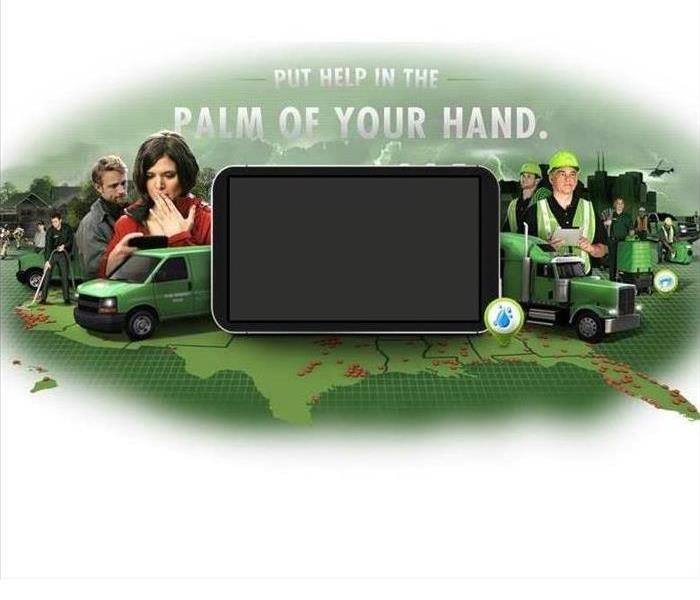 The SERVPRO Emergency Ready Plan smartphone app puts help in the palm of your hand!
The SERVPRO Emergency Ready Plan smartphone app puts help in the palm of your hand!
While storms can be dangerous and cause damage to your residence, they can be devastating to a business. According to FEMA, about 40% of small businesses never reopen following a disaster. One major issue that causes this is business owners not considering disasters as a major threat to their business.
The best way to help your business with disasters is to be prepared. We at SERVPRO of Norridge/Harwood Heights recommend the SERVPRO EMERGENCY Ready Profile (ERP) to help you prepare for this disaster. The ERP is an app designed to prepare you and your properties in case of disasters.
Things the app can do
- You create individual emergency profiles for each property you own
- You can immediately submit a notice for fire, water, mold or general clean up through the app
- You can establish SERVPRO of Norridge/Harwood Heights as your disaster mitigation and restoration provider
The app can hold detailed information about your property to make sure that your business can minimize destruction and interruptions of your business' schedule.
We at SERVPRO of Norridge/Harwood Heights are happy to help in an emergency!
Summer Storms and Floods
5/15/2019 (Permalink)
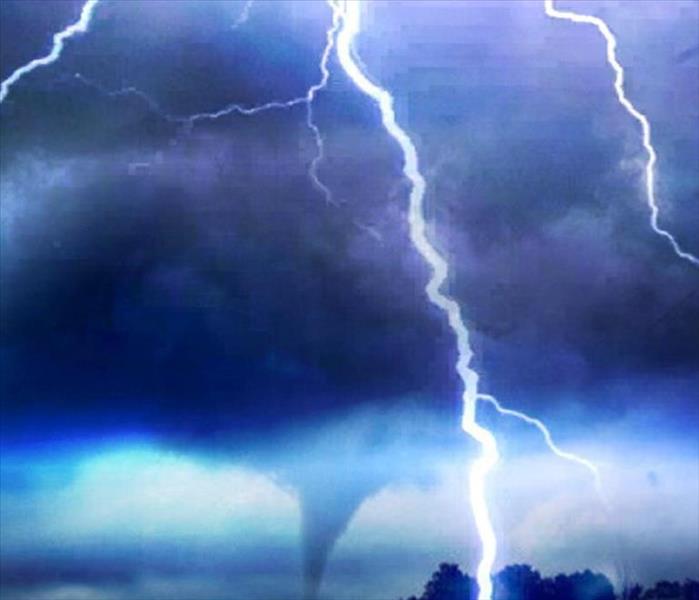 Storms bring all kinds of damage potential with them
Storms bring all kinds of damage potential with them
With summer approaching quickly, it's important to think about the storms that it brings. Thunderstorms bring heavy rains, strong winds, and occasionally hail or tornadoes. While tornadoes seem scary, more deaths are because of lightning than tornadoes. During a storm, it's important to stay inside and away from windows.
Flooding is also associated with large storms due to the heavy rains. Flooding is the number one severe storm killer, because people fail to realize the danger and power of water. Flash floods are the most dangerous, because they can sweep away everything in their paths. They occur often at night in mid to late summer.
If you find yourself caught in a flood, make sure to follow all instructions from local authorities, which could include evacuation. If evacuating, make sure to be careful on the roads, because two feet of water can carry away an automobile and follow all evacuation routes provided.
When you re-enter your home, check for fire hazards, inspect foundation for cracks, throw away all food (including canned goods) that have come in contact with flood waters, and check utilities. Do not come into contact with flood waters! They could be contaminated with things such as gas, oil or raw sewage.
SERVPRO of Norridge/Harwood Heights would like to remind you to be safe this summer among these storms!
Flood Risk
4/17/2018 (Permalink)
Proximity to water is the number 1 risk factor for flooding, but property owners should not assume being out of the floodplain will help you entirely avoid the possibility of flooding. It is always a best practice to locate your property as far away from bodies of water as possible. Flood maps available from the National Flood Insurance Program (NFIP) identify 100-year and 500-year flood zones throughout the United States. The flood zones also delineate participation in the NFIP, as well as permitting and other requirements that communities adopt in order to meet NFIP standards and qualify their citizens for lower flood insurance rates. By definition, the 100-year and 500-year flood zones mean there is a 1 (.20) percent chance of flooding annually in an area based on topography and historical data; it does not mean that flooding will occur only once in a century (or 500 years). There also are other important points to consider.
Safety During Storms
4/17/2018 (Permalink)
- Turn off the power and water mains if instructed to do so by local authorities.
- Boil tap water until water sources have been declared safe.
- Avoid contact with floodwater. It may be contaminated with sewage or contain dangerous insects or animals.
- Continue listening to local area radio, NOAA radio or TV stations for the latest information and updates.
- Don’t use gas or electrical appliances that have been flooded.
- Dispose of any food that comes into contact with flood water .
Staying Safe Outdoors
- Don't walk, swim or drive through floodwater. Just six inches of fast-flowing water can knock you over and two feet will float a car.
- If caught on a flooded road with rapidly rising waters, get out of the car quickly and move to higher ground.
- Don't walk on beaches or riverbanks.
- Don’t allow children to play in or near flood water.
- Avoid contact with floodwater. It may be contaminated with sewage or contain dangerous insects or animals.
- Stay out of areas subject to flooding. Underpasses, dips, low spots, canyons, washes, etc. can become filled with water.
Be Prepared
2/13/2018 (Permalink)
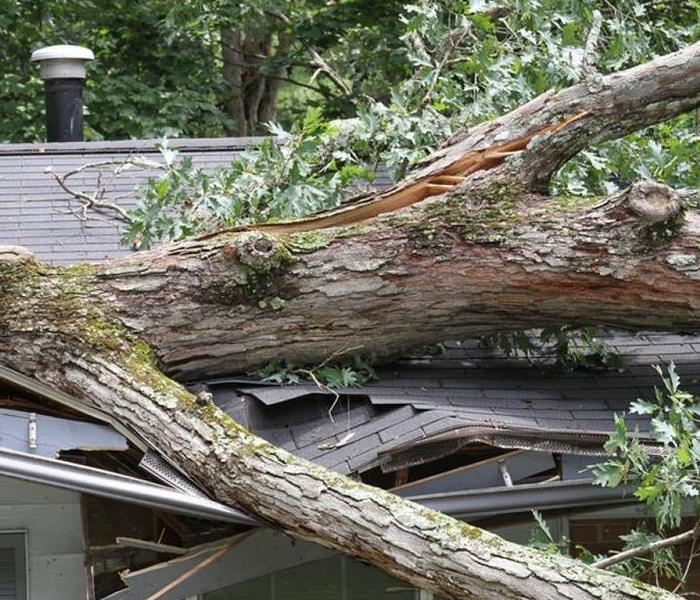 Storm Damage
Storm Damage
A thunderstorm is considered severe if it produces hail at least 1 inch in diameter or has wind gusts of at least 58 miles per hour. Every thunderstorm produces lightning, which kills more people each year than tornadoes or hurricanes. Heavy rain from thunderstorms can cause flash flooding, and high winds can damage homes and blow down trees and utility poles, causing widespread power outages.
Know the Difference
Severe Thunderstorm Watch - Severe thunderstorms are possible in and near the watch area. Stay informed and be ready to act if a severe thunderstorm warning is issued.
Severe Thunderstorm Warning - Severe weather has been reported by spotters or indicated by radar. Warnings indicate imminent danger to life and property.
Every year people are killed or seriously injured by severe thunderstorms despite advance warning. While some did not hear the warning, others heard the warning and did not pay attention to it. The information in this section, combined with timely watches and warnings about severe weather, may help save lives.
After The Storm
2/13/2018 (Permalink)
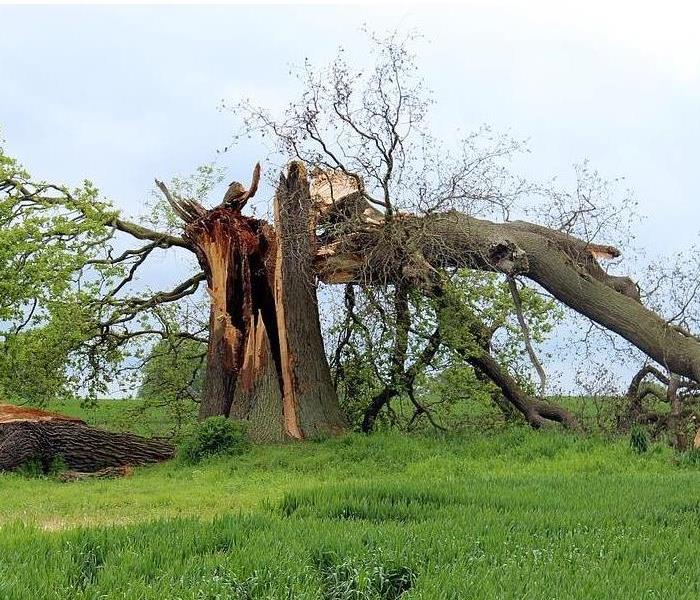 Stay Safe
Stay Safe
- Never drive through a flooded roadway. You cannot predict how deep the water may be.
- Stay away from storm-damaged areas to keep from putting yourself at risk from the effects of severe thunderstorms.
- Continue to listen to a NOAA Weather Radio or to local radio and television stations for updated information or instructions, as access to roads or some parts of the community may be blocked.
- Help people who may require special assistance, such as infants, children and the elderly or disabled.
- Stay away from downed power lines and report them immediately.
- Watch your animals closely. Keep them under your direct control.
If Lightning Strikes
Follow these steps if someone has been struck by lightning:
- Call for help. Call 9-1-1 or the local emergency number. Anyone who has sustained a lightning strike requires professional medical care.
- Check the person for burns and other injuries. If the person has stopped breathing, call 9-1-1 and begin CPR. If the person is breathing normally, look for other possible injuries and care for them as necessary. People who have been struck by lightning do not retain an electrical charge and can be handled safely.
Flood Prep
2/13/2018 (Permalink)
 8 inches of water in basement of home.
8 inches of water in basement of home.
Protecting Your Family
- Talk with your family about what to do if a flood watch or warning is issued. Discussing floods ahead of time helps reduce fear, especially for younger children.
- Ensure that every member of your family carries a Safe and Well wallet card.
- Make sure you have access to NOAA radio broadcasts:
- Find out if you are located in a floodplain, which is considered a Special Flood Hazard Area. If so, you are still eligible for flood insurance. Check with your city or county government (start with the Building or Planning Department) to review the Flood Insurance Rate Maps, published by the Federal Emergency Management Agency (FEMA).
- Find out if local streams or rivers flood easily.
- Keep insurance policies, documents, and other valuables in a safe-deposit box. You may need quick, easy access to these documents. Keep them in a safe place less likely to be damaged during a flood. Take pictures on a phone and keep copies of important documents and files on a flashdrive that you can carry with you on your house or car keys.
After a flood
2/13/2018 (Permalink)
 Flooded Home
Flooded Home
After a Flood:
- Let friends and family know you’re safe. Register yourself as safe on the Safe and Well website
- If evacuated, return only when authorities say it is safe to do so.
- Continue listening to local news or a NOAA Weather Radio for updated information and instructions.
- Keep children and pets away from hazardous sites and floodwater Returning Home Safely
- Beware of snakes, insects and other animals that may be in or around your home.
- If power lines are down outside your home, do not step in puddles or standing water. Report them immediately to the power company.
- If any gas or electrical appliances were flooded, don’t use them until they have been checked for safety.
- Dispose of any food that has come into contact with flood water.
- Take pictures of home damage, both of the buildings and its contents, for insurance purposes.
Contact SERVPRO of Norridge/Harwood Hts. for all water damage issues.





 24/7 Emergency Service
24/7 Emergency Service
